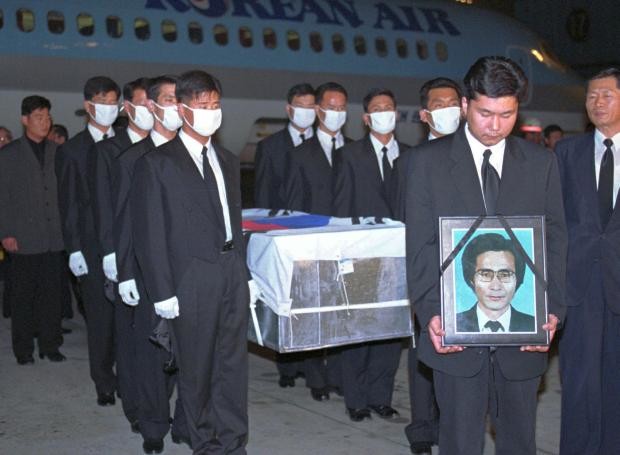Other mysterious deaths of North Korea’s perceived enemies

In this photo, taken Oct. 5,1996, government officers carry a portrait and a coffin containing South Korean Choi Duk-kun, a South Korean diplomat stationed in the eastern Russian city of Vladivostok, upon the body’s arrival at Gimpo International Airport in Seoul, South Korea. Choi was found dead in front of his apartment in 1996. He had head wounds, but his passport and money were still in his pockets. (Photo by YUN JAI-HYOUNG/AP)
SEOUL, South Korea — An outcast from North Korea’s ruling family was killed with a weapon believed to belong to North Korea’s chemical arsenal and several North Koreans are wanted for questioning. But with Malaysia deporting the only North Korean it detained in the airport assassination of Kim Jong Nam, many in South Korea see the secretive, dictatorial regime in Pyongyang escaping punishment for another mysterious killing.
The government in Seoul and human rights groups say Pyongyang has for decades acted to silence its perceived enemies, sending assassins after South Korean government officials, North Korean defectors and anti-Pyongyang activists.
And yet North Korea often takes out the targets without leaving evidence that would indisputably prove its involvement, South Koreans say.
When suspicions were expressed, North Korea responded with silence or with wounded indignation. Some of the mysterious deaths suspected of being carried out by North Korea:
Diplomat in Russia
Choi (pronounced Chwey) Duk-kun, a South Korean diplomat stationed in the eastern Russian city of Vladivostok, just north of North Korea, was found dead in front of his apartment in 1996. He had head wounds, but his passport and money were still in his pockets.
Article continues after this advertisementSouth Korea is almost certain North Korea organized a hit job on the diplomat who had been monitoring the North.
Article continues after this advertisementThe biggest evidence Seoul offers? He was stabbed with a sharp object on his right side, and investigators later found in his bloodstream traces of neostigmine bromide, a chemical that attacks the nervous system and was known to be frequently used by North Korean operatives.
The timing of Choi’s death was also suspicious. It came weeks after a North Korean submarine beached on South Korea’s east coast. Twenty-two North Koreans were killed by South Korean forces or were later found dead, prompting the North to vow “hundredfold and thousand-fold” retaliation.
Choi’s assailants were never caught. North Korea denied involvement and claimed it was framed by Seoul.
Missionaries in China
North Korea hates South Korean activists, many of them evangelical Christians, who smuggle out defectors and send anti-Pyongyang literature and Bibles into the North across the border from China.
South Korea believes Pyongyang killed at least one of them, Patrick Kim, a 46-year-old pastor who died in August 2011 after collapsing in the Chinese border city of Dandong.
South Korea said Kim was likely attacked by a North Korean agent using a poisoned needle. Investigators detected in Kim’s body neostigmine bromide, the same chemical found in the diplomat in Vladivostok.
A day after Kim’s attack, Kang (pronounced Gahng) Ho-bin, another South Korean missionary who helped defectors, was stabbed in the back with what officials believed was a poisoned needle in another Chinese city, Yangji.
The assailant wasn’t captured. Kang survived the attack, but was killed in 2012 after his car collided with a bus in the Chinese city of Longjing.
There are suspicions that North Korea also assassinated Han Chung Ryeol, a Korean-Chinese pastor who was found dead in the Chinese county of Changbai last year with slash wounds to his neck.
Turncoats in the South
South Korea almost immediately blamed the 1997 death of Lee Han-young, a nephew of one of the former wives of North Korea’s second leader, Kim Jong Il, on North Korean agents sent on a revenge mission. But police failed to catch the assailants before they allegedly returned to the North.
Lee died of gunshot wounds after being attacked in front of his apartment near Seoul in 1997. According to his neighbors, Lee after the shooting said, “spy, spy,” and held up two fingers, perhaps indicating the number of attackers. Police said a woman purporting to be a magazine reporter called the apartment to ask when Lee would be home before the attack.
Lee had defected through Switzerland in 1982, but Seoul kept his arrival secret until 1996, when his mother also fled the North. He had harshly criticized the country and his dictator uncle.
South Korean officials said that Lee’s killing might have also been North Korea’s way of sending a message to Hwang Jang-yop, a former North Korean Workers’ Party secretary who defected to the South earlier in 1997.
Hwang, who once tutored Kim Jong Il and remains the highest-level North Korean to seek asylum in South Korea, survived what the South said was an assassination attempt by the North in 2010. He died six months after his would-be assailants were arrested, at the age of 87. –Kim Tong-Hyung